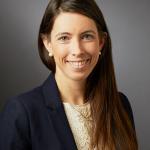
Krystal Pollitt, Ph.D.
Dr. Krystal Pollitt is an Assistant Professor of Epidemiology and Chemical and Environmental Engineering at the Yale School of Public Health. Her research examines how exposure to air pollutants affects human health, and she focuses on how this impacts vulnerable populations. With her lab, Dr. Pollitt has developed the Fresh Air wristband—a wearable air quality monitor that detects human exposure to thousands of chemical compounds in the air as they go about their daily life.
Why is air quality such an important issue to study?
Air is a resource that we take for granted. We're breathing it in, and during COVID people are starting to notice that not all air is good air, even if they are living in good air quality regions. The need for masks changes your perspective on what it means to have clean, fresh air around you. That's really been the motivation for understanding what air pollution means in terms of quality of life and in terms of health. The burden of disease that is associated with poor air quality is huge, especially when you start to move to low- and middle-income countries, or in regions of exposure disparities across the US.
Why work with Earthwatch?
Earthwatch has enabled me to go further and to start to think about what people are exposed to in their day-to-day lives, and how we can be preemptive in our decision making, our behavior, and our choices to reduce our exposure to unhealthy air.
Operation Healthy Air has been using Purple Air sensors that measure pollutant particle concentrations in real-time. And now we’re also using the passive air monitors that I’ve developed within my research group. They give slightly different information, so together they allow us to look at the chemical signature of all the chemicals in the air around a person. With these sensors, we can get fingerprints of hundreds of thousands of different chemicals that people are exposed to. Allowing us to think about industrial and personal factors are contributing to those exposures– and then look at how they differ within and across a city. That's what I'm really excited to be able to learn through this project.
How important it is to monitor air quality at a community or street level?
With these wearable technologies, we can start to get at individual level exposures. This lived experience encapsulates not only our outdoor exposure that regulatory monitors get at, but also our indoor exposures, which are so personalized based on our home environments, our work environments, and our behavioral choices that we're not able to capture them otherwise.
Education
- PhD King's College London, Environmental Toxicology (2012)
- MSc University of Toronto, Chemical Engineering (2008)
- BSc University of Toronto, Chemical Engineering (2005)